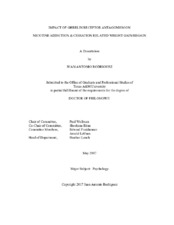| dc.description.abstract | Nicotine (NIC) addiction remains a prevalent concern in the US. The number of users continues to climb while cessation success remains low due to the lack of successful available options for quitting. NIC, a well-known weight control substance, is appealing for the obese and those who fear becoming obese. Obesity, too, is a major concern that remains difficult to treat and overcome. One speculation is that NIC cessation-related weight gain provides an increased likelihood of relapse and continued use. Ghrelin (GHR), a gut peptide, has been implicated in the endogenous reward system of appetitive behaviors, including smoking and unhealthy dietary intake. The effects of GHR on feeding and psychostimulant function, accompanied by findings on GHR receptor (GHR-R) manipulation, has lead us to investigate possible pharmacological dual-treatment approaches for both NIC dependence and smoking cessation-related weight gain. The mechanisms of action for NIC and literature supporting GHR’s involvement in NIC addiction that favor a dual-treatment hypothesis are investigated here.
Experiment 1 examined the antagonistic effects of the GHR-R antagonist, JMV- 2959, and the agonistic effects of GHR on intracranial self-stimulation (ICSS). Experiments 2-3 examined the effects of JMV-2959 on NIC and cocaine intravenous self-administration (IVSA). Experiment 4 examined the effects of GHR on cocaine IVSA. Experiment 5 examined the effects of JMV-2959 on NIC-cessation related highfat (HIFAT) food intake and weight gain. Experiment 6 examined the potential of JMV- iii 2959 to induce malaise in a conditioned taste aversion (CTA) task.
The results for Experiment 1 show that JMV-2959 and GHR alone are incapable of mitigating reward-seeking behavior in ICSS. Experiments 2-4’s results show that JMV-2959 diminishes the reinforcing effects of NIC and COC IVSA, while GHR alone failed to alter COC IVSA. Experiment 5’s results support the notion that JMV-2959 may be a useful tool in curbing the general weight gain and NIC cessation-related weight gain. Experiment 6’s results confirm that JMV-2959 does not induce malaise. Collectively, these experiments provide evidence that GHR is involved in rewardbehavior and that antagonism of GHR-Rs may provide a serious pathway for the dualtreatment of NIC addiction and weight gain, potentially mitigating drug-seeking for other psychostimulants. | en |


